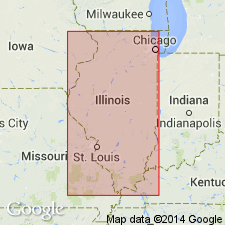
- Usage in publication:
-
- Buckhorn member
- Modifications:
-
- Original reference
- Dominant lithology:
-
- Dolomite
- AAPG geologic province:
-
- Wisconsin arch
Summary:
Figs. 3, 9. Buckhorn member of Dunleith formation. Dolomite, argillaceous, with green shale partings; contains bentonite zone. About 6 feet thick. Shown on columnar section (fig. 3) as underlying St. James member (new) and overlying Glenhaven member (new) of Guttenberg formation. Age is Middle Ordovician.
[Notable exposures in Dixon-Oregon area, northern IL.]
[GNC remark (ca. 1966, US geologic names lexicon, USGS Bull. 1200, p. 514): In the copy of the guidebook used by the compiler [G.C. Keroher], in figure 3 the name Buckhorn had been crossed out and the name Red Oak written in. Likewise, the name Glenhaven had been crossed out and the name Garnet written in. Thus, the sequence would read (descending) St. James, Red Oak, Garnet. However, in figure 9, the name Glenhaven had not been changed. Since the compiler had no way to determine what changes, if any, had been made in other copies of the guidebook, it was impossible to be certain which names were to be retained.]
Source: US geologic names lexicon (USGS Bull. 1200, p. 514).
For more information, please contact Nancy Stamm, Geologic Names Committee Secretary.
Asterisk (*) indicates published by U.S. Geological Survey authors.
"No current usage" (†) implies that a name has been abandoned or has fallen into disuse. Former usage and, if known, replacement name given in parentheses ( ).
Slash (/) indicates name conflicts with nomenclatural guidelines (CSN, 1933; ACSN, 1961, 1970; NACSN, 1983, 2005, 2021). May be explained within brackets ([ ]).

